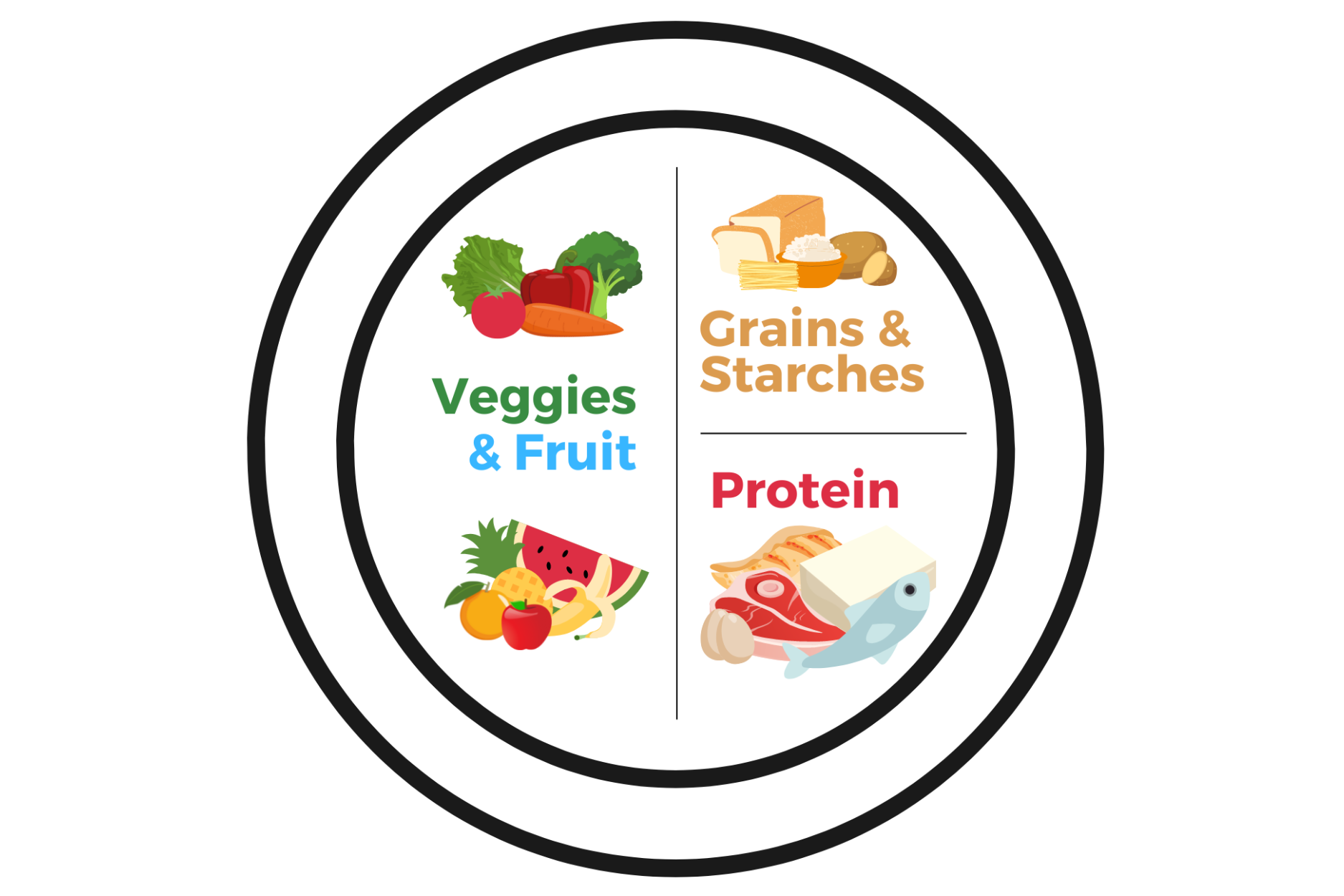How to Build a Healthy Plate
One of the easiest ways to clean up your diet and eat healthy is to follow what I call the Healthy Plate Model.
I built this model a few years ago as a visual guide to help my clients put healthy foods on their plates at every meal.
This model is based in large part on the USDA’s MyPlate model that was published in 2015. It shows what your plate should look like at meal times according to four major food groups: vegetables (veggies), fruit, protein, and grains/starches.
Click below to download a printable version of the Healthy Plate model to keep in your kitchen as a reminder:
Know Your Food Groups
What I love most about the Healthy Plate model is its simplicity and adaptability. Keeping the Healthy Plate graphic in mind, there are infinite combinations of healthy meals that you could create. All you have to do is know your food groups:
Veggies (Vegetables)
On half of your plate, include 1-2 servings of veggies. Veggies (or vegetables) are plants (or parts of plants) that you can eat. Fruits and grains are also plants, but we usually reserve the term “vegetable” for specific parts of the plant like the roots (like carrots and turnips), leaves (like lettuce and spinach), stems (like celery), bulbs (like garlic and onion), and flowers (like broccoli). Veggies are a great source of carbohydrates and healthy fats (i.e., unsaturated fats).
Fruit
Fruits are plant products that tend to be higher in sugar content, giving them a sweet taste. This group is optional and can take up 1 portion of the vegetable side of your plate. They include things like berries, cherries, apples, grapes, pears, and mangoes. The higher sugar and calorie content of fruits make them a food to be eaten in moderation–no more than a quarter of your plate at meal times.
Protein
On at least a quarter of your plate, include a lean source of protein. Protein is both a source of energy for your body and a building block for your body tissues (like muscle). Eating a high-protein diet will help your body to more efficiently build muscle and keep your metabolism boosted (high-protein in this context means 20% of your daily calories come from protein). Prioritize lean sources of protein–items that come with little to no saturated fat like white meat (chicken breast & turkey breast), egg whites, fish, plant protein sources (tofu, tempeh, & edamame), and lean cuts of red meat.
Grains/Starches
On the remaining quarter of your plate, include a grain or starchy food. Grains are essentially seeds and include foods made from wheat (bread & pasta), rice, quinoa, and oats. Try to include whole grains as much as possible (things like brown rice, oatmeal, whole wheat, quinoa, etc) in place of refined grains (white wheat, white bread, or white rice). Whole grains are more generally more nutritious, having more vitamins, minerals, and dietary fiber than refined grains.
Some vegetables (like potatoes, corn, yuca, and plantains) are high in Starches (complex carbohydrates). Starchy vegetables tend to be high-calorie, and may not be suitable for every diet (for example, people with Type II Diabetes may want to avoid them). These kinds of vegetables should be limited to no more than a quarter of your plate, especially if you are trying to burn fat.
Tips for Building a Healthy Plate
When you first start to practice the Healthy Plate model, you’ll likely need to experiment a lot to find what recipes you like and what works best for you.
Cookbooks are a great resource that may already be in your kitchen or bookshelf at home. General cookbooks like the Better Homes & Gardens New Cookbook and Betty Crocker’s Cookbook have entire chapters devoted to vegetable-based dishes, meat, breads, pastas, and more. Specialty cookbooks like the America’s Test Kitchen Complete Vegetarian Cookbook are full of recipes dedicated to one of the major food groups.
Online recipes are another easy and accessible resource. The MyPlate Kitchen website has tons of recipes, videos, and other resources to help you build healthy plates at home. Another great tool is allrecipes.com—a site that allows you to search for healthy recipes using whatever ingredients you’d like to use. It also has plenty of cooking tips and meal ideas to browse and is updated pretty regularly!
You can also check out my recipe collections available here on my website. I update these collections every few months according to the most popular or requested recipes.
For more guidance on building a healthy diet, check out my Healthy Diet Makeover program. This short course can be done in as little as two weeks, during which you’ll learn more about building a healthy plate and how to eat to reach your fitness goals. Click below to learn more!
About Jayd
Hey there! 👋 I’m Jayd Harrison (aka Jaydigains), a health coach, personal trainer, and host of the Coaching Corner Podcast. I help people build muscle, burn fat, and clean up their diets with my online coaching programs and fitness content. Check out some of my coaching videos on Youtube, join me live on Twitch, and follow on social media.
Sign up for updates ✉️
Sign up for more exercise tips and get notified whenever I post to the Nutrition Blog. Fill out the form below:
Your privacy is important to me! I will never share your information with any third party. Update your preferences or unsubscribe from the email list at any time.






